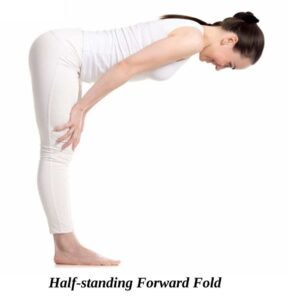The Half-standing Forward Fold Pose in Yoga
- Focus: Hamstrings, calves, back
- Level: Beginning
- Total Time: 60 seconds
- Indications: Stress
- Contraindications: Back injury

Standing Half Forward Bend (Ardha Uttanasana)
- From the forward fold, raise your torso until your flat back is parallel to the ground. Place your hands on the front of your legs. Breathe in, draw in your abdomen and use your back muscles to support your torso and keep your spine straight.
- Maintain length from your head to tailbone through your spine
- Pull your shoulder blades away from your ears and gaze forward
- Breathe several times before rising to an upright position and resting, with feet slightly separated, in mountain pose.
Warming Up For Yoga
- Everybody knows the importance of stretching before running or working out, but what kind of warm-up does yoga require? While traditional stretching is helpful before performing yoga, since most yoga poses are advanced stretches in and of themselves, there are a number of yoga positions you can use to warm up before you delve into the more involved practice.
- The unique aspect of warming up for yoga is the process of centering oneself, at the same time you wake up your muscles. A yoga physical warm-up is also a mental warm-up that allows you to move away from your other preoccupations and reach a calm mental stance that will assist you in further yoga work.
- An ideal yoga warm-up will include poses that involve both your upper and lower body. It should incorporate stretches that attend to your wrists, your neck, and your spine, key parts of your body that receive the most work when you’re doing yoga. In this chapter, you will discover some great poses you can use as part of your personal warm-up routine.
Yoga Latest Post :- Click Here
TOP YOGA MCQs Questions and Answers
1. Which is the Sanskrit root (verb form) for the etymological derivation of the word “Yoga”?
(A) Yug
(B) Yuge
(C) Yuj
(D) Yuje
Click to show/hide
2. Who was the Yoga Guru of Swami Kuvalayananda?
(A) Pattabhi Jois
(B) T. Krishnamacharya
(C) Madhav Das
(D) Yogendra
Click to show/hide
3. Which of the following practice leads to immortality, according to Ishavasyopanishad?
(A) Vairagya
(B) Viveka
(C) Vidya
(D) Vishaya
Click to show/hide
4. Definition of Yoga according to Kathopanishad is
(A) Control on mind
(B) Control on sense organs, mind and intellect
(C) Control on sense organs and intellect
(D) Control on body and mind
Click to show/hide
5. How many types of Kundalini by nature are described in Siddha Siddhant Paddhati?
(A) 02
(B) 03
(C) 04
(D) 06
Click to show/hide
6. Which Upanishad described the ‘Shandilya Vidya’?
(A) Kathopanishad
(B) Brihadaranyakopanishad
(C) Aitareyopanishad
(D) Chhandogyopanishad
Click to show/hide
7. Which of the following are the types of Pranayama, according to Patanjala Yoga Sutra?
I. Stambhavritti Pranayama
II. Sahita Pranayama
III. Bahyabhyantara Vishayakshepi Pranayana
IV. Kevali Pranayama
Use the codes given below for correct answer:
(A) I and II are correct.
(B) II and III are correct.
(C) I and III are correct.
(D) II and IV are correct.
Click to show/hide
8. Given below are two statements, labelled as Assertion (A), and a Reason (R). Indicate your answer from the alternatives below:
Assertion (A): Pashchimōttanasana is contraindicated in sciatica.
Reason (R): Pashchimōttanasana is a type of forward bending asana.
All types of forward bending asanas should be contraindicated in sciatica. In the context of above two statements, which one of the following is correct?
(A) Both (A) and (R) are true and (R) is the correct explanation of (A).
(B) Both (A) and (R) are true, but (R) is not the correct explanation of (A).
(C) (A) is true, but (R) is false.
(D) (A) is false, but (R) is true.
Click to show/hide
9. In which of the following text ‘Bhujangikaran’ Pranayama is described?
(A) Yoga Vashishtha
(B) Shiva Samhita
(C) Hatha Ratnavali
(D) Siddha Siddhanta Paddhati
Click to show/hide
10. What do you understand by the term ‘Adhi’?
(A) Physical disorders originated in Annamaya Kosha.
(B) Mental/Emotional disorders originated in Manomaya Kosha.
(C) Mental/Emotional disorders originated in Annamaya Kosha.
(D) Physical disorders originated in Manomaya Kosha.
Click to show/hide
11. Which day is celebrated as ‘International Day of Yoga’?
(A) June 20
(B) June 21
(C) June 22
(D) June 23
Answer ⇒ ????
